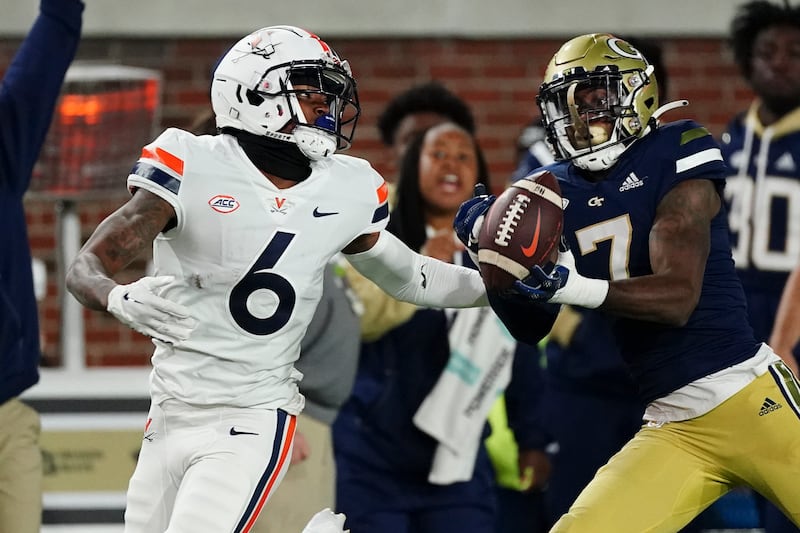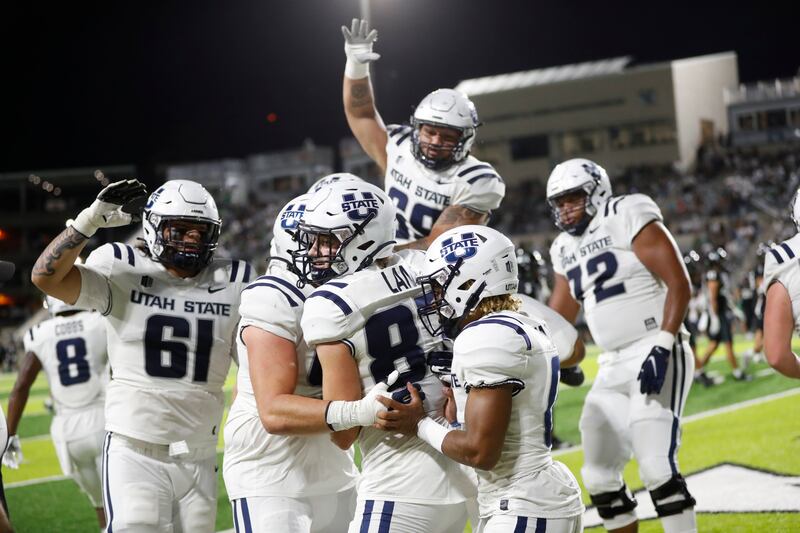The Bronco Mendenhall era at Utah State has never been nearer.
Starting Wednesday in Logan, fall camp begins for the Aggies, who open the 2025 season at home against UTEP on Aug. 30.
With 70 new players on the roster for the 2025 season, Utah State is far from its 2024 version.
Which means there are a lot of questions entering fall camp.
Here are five storylines to follow — among many — as Utah State prepares to open the 2025 season.
Do the Aggies have enough behind Bryson Barnes?

Not since Jordan Love in 2019 has a Utah State starting quarterback made it through an entire season (including the postseason) without missing time due to injury or demotion. And over the last 10 years, only one other Aggie starting QB has managed to be the guy for the entire season — Kent Myers in 2016.
Logan Bonner nearly did it when he led USU to a Mountain West championship, but he got hurt at the LA Bowl, giving way to Cooper Legas.
Bryson Barnes is QB1 for Utah State entering the 2025 season. His blend of experience, arm talent and mobility make him a versatile tool for offensive coordinator Kevin McGiven to work with.
McGiven told the Deseret News Tuesday that he isn’t wedded to any particular offensive style — gone are the days of “all gas, no brakes” — which makes Barnes almost the ideal signal caller.
Barnes is definitively the guy in Logan and his teammates are pretty high on him.
“Bryson is great to have around,” receiver Braden Pegan said. “He’s a great leader. He leads the offense very well. He’s been throwing the ball around, which us receivers love, so we’re excited to see what goes on.”
If recent history is any indication, though, Barnes won’t be USU’s starting quarterback in every game this season, which means the Aggies need to have prepared backups, and they know it.
McGiven cited his own previous experience in Logan as evidence, recalling the 2014 season when Myers, Chuckie Keaton, Darell Garretson and Craig Harrison all played. It got so bad that the Aggies briefly had to turn to wide receiver Ronald Butler at quarterback.
Behind Barnes, the Aggies have Arizona transfer Anthony Garcia (who was with McGiven at San Jose State before that), former BYU and Arizona State QB Jacob Conover, former Boise State QB CJ Tiller, and former Ridgeline High star Kaden Cox.
None of the aforementioned are especially proven. Conover has the most experience, but he’s never thrown more than 38 passes in a single season.
Garcia looks like the ideal backup, with a good blend of size (6-foot-2, 193 pounds) and athleticism, and Tiller is similar (6-foot-1, 200 pounds).
With the starting QB decided, can the Aggies develop viable backups this fall?
Can the offensive line live up to its potential?
On paper, there is no position group that is better positioned to be successful this season for Utah State than its offensive line.
The Aggies returned three players who started at least a game last season in Trey Andersen, George Maile and Tavo Motu’apuaka. And then there is Jared Pele, who played in 11 games, albeit primarily on special teams.
Utah State also brought in some notable reinforcements, including Jimmy Liston (Purdue) and Jake Eichorn (BYU).
There is real size, experience and talent on the Aggies O-line, and position coach Mario Acitelli has already garnered considerable praise for his work with the group.
Is it real, though? And can the O-line be good enough to keep the Aggies’ offense among the better attacks in the Mountain West Conference?
Defensive tackle Tyree Morris, a 6-foot-5, 285 pounds transfer, is a believer.
“I think our O-line is going to be really good this year,” he said. “We got good players. Going against them, for me, was different because I came from (an FCS school), so it’s a lot stronger, more physical.
“But I really think that going against each other (in camp) is going to help, because we’re all working to get better, so it’s just going to improve day by day, practice by practice. I really think our offensive line is gonna be good.”
Maile is perhaps the most notable player on the O-line, as a former four-star prospect who transferred to USU from Baylor. And he’s confident in this Aggie group.
“I would say we’re really solid,” Maile said. “A lot of guys on our team are experienced, played a lot last year. And the guys that we brought in, they’re great additions to the team. So I can’t wait to go.”
McGiven noted that the O-line progressed well during spring camp and summer workouts have been a real positive, too.
All signs point to Utah State’s O-line being a real strength for the team, and a good fall camp by the group could significantly raise the ceiling for USU in 2025.
Who steps up at receiver?

Of the top 12 pass catchers for Utah State last season, only two are back in Logan and both are tight ends (Broc Lane and Josh Sterzer).
All of the Aggies’ top wide receivers are gone, replaced by transfers from all over, including the Big Ten, the Big 12, the Mountain West and Conference USA.
Of all the position groups on the roster, none is less proven than the wide receivers. Many of the transfers brought in don’t have much experience or at least haven’t proven they can be productive at the FBS level, which means that practically every receiver on the roster is a real question mark.
That doesn’t mean there isn’t optimism about the group, though.
Mendenhall and McGiven both expressed their belief that Utah State has talent in its wide receiver room, players who are going to make major impacts this fall.
Guys like Braden Pegan on the outside as a deep threat, or Demick Starling (who played for Mendenhall at Virginia) or Brady Boyd in the slot. UNLV transfer Corey Thompson Jr. is currently dealing with a shoulder injury, but Mendenhall singled him out as well.
“When we went for experience to address the lack of starters, I believe we went four for four,” Mendenhall said. “Not only on the quality of player, but the type of person, and that’s really helpful.
“... We now have, in theory, upperclassmen with existing players in the program, and then younger players. So the room has become healthier pretty fast. We’re not as deep as I would want yet, but we’re on our way. So I think we’ve done a nice job.”
Mendenhall isn’t alone in that belief.
“I really like our receiver corps,” said senior linebacker John Miller. “They’re scary. They’re gonna do some damage for us, and I’m excited. I just really want to see that play out honestly.”
Will the Aggies have a serviceable defensive line, or better?

If you wanted to lay blame for the Aggies’ struggles defensively over the last few years, it would be fair to single out the defensive line.
For many reasons, including injuries and a lack of game-changing size and strength, the Aggies have struggled to field even a serviceable defensive front for a few years now.
That doesn’t mean that there weren’t talented players on the line, but as a group, USU’s defensive line has been a real weakness — maybe the weakness for Aggie football.
But after adding a large crop of transfers, there is reason for optimism.
Morris, an FCS transfer, is arguably the biggest defensive tackle USU has had in years. Snow College transfer Joshua Papu is right behind him at 6-foot-3 and is wider at 300 pounds.
Naki Fahina, Nuuletau Sellesin — go down a list of the newcomers and it is clear that the Aggies tried to get bigger in a hurry.
“We recruited big people,” defensive line coach Donte Wilkins said. “If you just look at the guys that we brought in, we brought in some height, we brought in some girth.”
It isn’t just about size, though.
The Aggies needed to get meaner up front, more committed to controlling the line of scrimmage. And they believe they have.
“We will have accountability,” Wilkins said. “It is not OK for that ball to move, in our opinion. And we talk about building a wall, guys are on the defensive line for a reason. They’re supposed to be big, they’re supposed to be physical, they’re supposed to be nasty. When they’re on a football field, you’re supposed to be afraid of them.”
Miller, from his linebacker position, saw up close what bad defensive line play looked like last season. He was plenty busy at his position — too much, even.
And he’s optimistic about what his job will look like this year, given the guys in the front of him.
“They look phenomenal, to be honest,” Miller said. “They look phenomenal. Bringing a guy back from last year, Gabe Iniguez Jr., he’s the sole leader of that whole D-line. He’s a sole leader. He’s also one of the big leaders on the defense too. ... He’s making sure everybody’s got all their Ps and Qss, right.
“And the D-line is going to be monsters this year. Like they all have been hitting crazy numbers in the weight room. I’ve been seeing them work really hard, and I’m super excited to see them eat, because they’re all dogs.”
Offseason workouts are one thing, but how the defensive line performs in fall camp will go a long way to determining if the Aggies can start playing serviceable defense again. Or better.
Will the returners be difference makers?

Utah State won’t look very familiar given all the changes, but there are some notable returners on the roster.
Players like Barnes, Miller, Iniguez, Maile and Andersen. There’s also safety Ike Larsen, tight ends Broc Lane and Josh Sterzer, defensive tackle Bo Maile, and edge Enoka Migao, all of whom have seen considerable playing time for the Aggies over the years.
In past coaching transitions, returners made a real difference for Utah State. It was the returners who were largely responsible for a lot of the team’s success going from one head coach to the next.
Go back to 2021 and players like Deven Thompkins, Nick Heninger, Shaq Bond, Cash Gilliam and Derek Wright were vital for Utah State and all were brought in by the Gary Andersen regime.
Go back to 2019 and it was Love, Gerold Bright, Jordan Nathan, Savon Scarver, David Woodward and Dominik Eberle. Without the established corps of returning contributors, the start of the Andersen era would likely have been an unmitigated disaster.
All of which is to say, for all the talent brought in under Mendenhall and company, it is the returners, the holdovers from the Blake Anderson/Nate Dreiling era who will determine how the 2025 season goes.
If they thrive under new leadership, the Aggies will surprise some people. If they don’t, it will surely be a difficult inaugural season under Mendenhall, with glimpses of a successful future coming late in the year.
This fall, those returners have to establish themselves as invaluable contributors. The question is, will they or won’t they?



